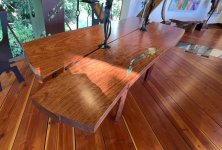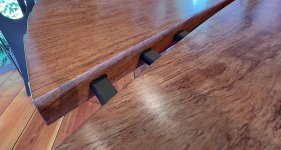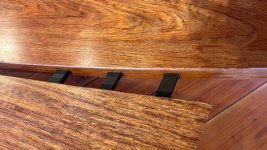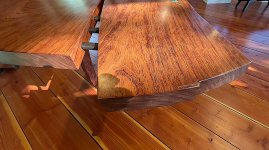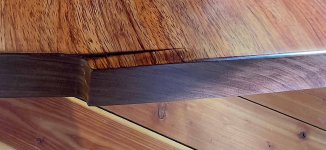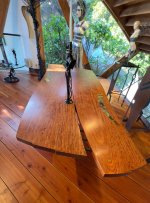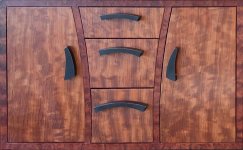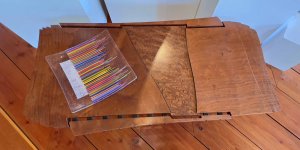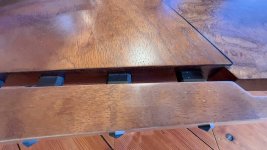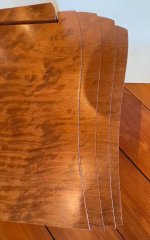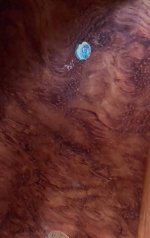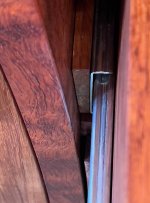You are using an out of date browser. It may not display this or other websites correctly.
You should upgrade or use an alternative browser.
You should upgrade or use an alternative browser.
Tell me this isn't wrong
- Thread starter smorgasbord
- Start date
smorgasbord
Member
squall_line said:Never mind the hardware, what's up with the plastic stick-on cover and the large white glob of whatever that is inside the cabinet door?
The doors at least appear to use solid wood, but the inside shelves look like edgebanded veneered plywood; the grain doesn't match at the corners.
Not that there's anything inherently wrong with that, but for what I'm imagining this thing was listed at (gallery-type pricing), ugh.
Yeah, but tbf, the stick-on cover looks like wood, just not the same wood nor the same finish. That seemed to be the maker's screw-hole cover of choice, as the door pulls have two of those covers as well.
I saw the piece and liked it, then opened the drawer and was dismayed. So while my wife was leaving I grabbed a couple of pictures without really looking further. I don't even remember the price, but $4,500 would be in line with other things there.
jeffinsgf said:Nor did the maker have the sensibility to put the "C" face down on the drawer bottom and hide that horrid patch.
woodbutcherbower said:The oddball stuff on the cabinet walls is off-putting for sure - but what offends me the most is the raw plywood drawer base with a humongous knot in it. It’s almost like the guy ran out of time towards the latter stages of the build. It’s a shame, because the rest of it is really nice.
My recollection is that it appeared to be just a sheet of ¼" pre-finished plywood, and yeah, not that good a grade, not to mention the builder not even caring.
Vtshopdog said:I think it's really beautiful and actually seems a fairly doable project if one were inclined to borrow the general design.
I agree. the main box is apparently screwed to the side supports, as that's what the cover on the inside of the door cabinet is for.
Yeah, but to use ¾" stock for all the drawer parts AND the secondary drawer front and just butt them all up is really clunky.Packard said:Once you decide to forego dovetails for the drawers, you really do need easy sliding drawers…
Packard said:In fairness to the builder, someone sketch what conventional wood drawer runners would look like in the furniture box with curved sides? I don’t see how it could reasonably be done.
The Blum and similar undermount "invisible" slides can be attached to a shelf as well as to the side of the carcase. So, having a shelf in between the drawers would be the easy way mount invisible slides.
For wood runners, yes, you'd need to fabricate some angled support that attached to the curved sides, but with that small a height a flat angled side that was screwed in place would probably be fine.
woodbutcherbower said:It looks great with the doors and drawers closed, but a top-dollar piece should feature soft-close undermounts (I use the liquid-damped Grass Dynopro ones), and proper recessed butt hinges. Those lay-on hinges only belong on a kitchen cabinet IMO.
Yeah, that's what initially set me off. If you're going to use hardware in a top-dollar piece, at least use top-dollar hardware. I could see not wanting to have butt hinge hardware visible when the doors were closed, which is why I suggested Soss hinges (and they make a nice black version in the needed size).
kevinculle said:So now the dovetailed drawer corner is a vestigial feature...no longer required for structural integrity and thus reduced to a design flourish and artistic bona fide.
All true, but I personally like the look of nicely cut dovetails and as long as they're actually structural I have no problem with them. I do personally dislike most router-cut dovetails though as the uniform spacing combined with thick pins strikes me as ugly, but I'm sure my knowledge of how they're machined is affecting my judgement.
Packard said:The butt joints on the drawers should be the other direction too. Constantly pulling any glued fastener in tensile is a no-no in my book. If it was the other direction the dominoes or dowels would be in shear, a stronger, longer lasting joint.
Yeah, I didn't have enough time with the piece, and totally missed that, but you're absolutely right. Even if lowly biscuits were used, the drawer would be stronger with a full side construction - and I think look slightly better, too.
Packard said:The butt joints in the cabinet box not only looks wrong, it stresses the fasteners in the wrong vector. For that construction, builder likely either used dominoes or dowels. In any case, the entire weight of the contents of the cabinet are stressing the fasteners in shear. If the butt joints were in the “correct” direction, they would not be stressing the fasteners at all.
Crazyraceguy said:For me, scrolling down the pics, the first thing I saw was butt joints going the wrong direction. Regardless of the joinery method or strength, this is never acceptable to me. It just screams wrong.
IIRC, the top is not attached attached to the 4 legs. The top is supported by the top of the carcass, with the sides of the carcass screwed to the legs that support the piece. So, having the top of the carcass lie on top of the sides of the carcass actually reduces stress on any joinery in the top/side carcass corner, except when carrying the piece by the top (which maybe is when damage is mostly to occur, hmmm). The very bottom of the carcass is hanging, but there's no actual weight being put on it except to support its own weight, so that's not a problem in my view.
Everything veneered was my first thought, too, but the top and drawer and door fronts are solid. If I go back I'll take a closer look.Packard said:Of course everything looks veneered to me. So maybe he used screws under that veneer. Even so, screws would be stronger in shear than in tensile. So still the butt joints are in the wrong direction.
Crazyraceguy said:There's a lot going on with this, in the pics and the comments. [blink]
Yeah, this has turned into a fun and educational thread - thanks everyone!
Your second (drawer guide) and third (cup hinges) were what made me pull my phone out of my pocket and grab a few pictures before catching up with my wife.Crazyraceguy said:Second was the drawer guides. In a piece like this, I would expect wood, but would not be offended by undermount metal.
Next, the cup hinges. Again, I would expect almost any other form, exposed leaf hinges being the least desirable. Soss, knife, or some other un-obtrusive would be far better.
The FastCap style patch/plug is most offensive because no attempt was made to disguise it, no stain....nothing.
I would assume that the "extra hole" was a first position of the shelf? which was changed? or even an alternate, that we can't determine from the photo?
The FastCap style plug is, I believe, for a screw that attaches the side of the carcass to the black filler piece that goes into the front leg. The same plugs are used for the drawer handle screws.
Crazyraceguy said:I have no problem with the concept of veneering, especially on interior parts, but the grain direction?
It has to be going the same way as the bottom.
If I get out there again, I'll take another look and snap more pictures.
Crazyraceguy said:Bottom of the drawer, no problem with the plywood, but not with the patch. I wouldn't consider the "it's covered up in use" as acceptable either. Cover it up with a piece of leather.....ok. Veneer it too? better.
Yeah, that "patch" was so egregious that at first you don't believe it's there. Or that you're wrong to hate it. It's like Wendell Castle hammering a bent nail into one of his beautiful chest of drawers on purpose back in the day.
That's an optical illusion - all three drawer pulls are the same size.Crazyraceguy said:I also dislike the sizing and location of the drawer pulls. It seems odd that the longest pull is on the narrowest drawer.
You're right. I'd suggest equal distance from the top of the drawer, but I think a single pull, narrower design is called for..Crazyraceguy said:The spacing seems disproportionate too. For me, they either need to be equal or centered on the vertical dimension.
I think the look of the thick top floating above the carcass is pretty good, actually, That the tops of the legs are cove-ed and don't actually touch the top gives the piece a jaunty jibe that works precisely because the top is thick and heavy and so are the legs. I'd have recessed the three top to carcass supports (square in cross-section) back further from the front to reinforce that disconnect.Crazyraceguy said:I'm thinking that an edge treatment of some kind was a missed opportunity. Maybe a cove? That might be too much, but it would be worth a test.
Crazyraceguy said:I sure hope [member=77266]smorgasbord[/member] didn't build this and come at it with a story of "seeing to somewhere".....he will never talk to us again...... [big grin]
ChuckS said:I'm sure CRG's is just a tongue-in-cheek comment for fun.
Yeah, I'm loving all the comments and disagreements on what is the worst and even disagreements on what to do differently. For all the mechanics of how to build stuff and what tool is best, etc., I think it's also good to have what designs support what aesthetics discussions, too.
smorgasbord
Member
Here's another piece of furniture from the gallery. This one caught my eye because of the apparent use of Domino-style mortises, and very exposed, actually revealed, rounded tenons that if you look closely don't even attempt to fill the mortise. I think it's a dining room table:
[attachimg=1]
[attachimg=2]
[attachimg=3]
The end edge treatment was also pretty unique and I think it works:
[attachimg=4]
[attachimg=5]
Also the table had some inlay or epoxy thing going on that I didn't pay attention to:
[attachimg=6]
The same maker had done a coffee table with the same exposed domino style tenons. Not sure what posting pictures of that would do, but it's clearly this maker's style.
[attachimg=1]
[attachimg=2]
[attachimg=3]
The end edge treatment was also pretty unique and I think it works:
[attachimg=4]
[attachimg=5]
Also the table had some inlay or epoxy thing going on that I didn't pay attention to:
[attachimg=6]
The same maker had done a coffee table with the same exposed domino style tenons. Not sure what posting pictures of that would do, but it's clearly this maker's style.
Attachments
luvmytoolz
Member
smorgasbord said:That's an optical illusion - all three drawer pulls are the same size.
Whoaa! What?? That's amazing!
smorgasbord
Member
ChuckS said:The size of the pulls must be distorted by their backgrounds (the widths of the drawers to which they're attached to).
That's what I thought, but LMTz amazement made me relook. I used Photoshop's perspective crop tool to remove the perspective and got this:
[attachimg=1]
And sure enough, the pulls get wider as the drawers get narrower. Now I'm convinced this designer/builder needs some real help.
Attachments
smorgasbord
Member
ChuckS said:Are you saying even the vertical pulls are different in size?
No, the horizontal ones for the drawers get wider as the drawers get narrower (but taller).
The vertical pulls on the two doors appear to be the same size.
The table is pretty cool. Must weigh a ton.
Just my taste (and mine alone, so who really cares, LOL) but I’ve never been a fan of most epoxy inserts in live edge stuff. Just seems like people end up trying too hard and insert can detract from a simple beautiful piece of wood.
Just my taste (and mine alone, so who really cares, LOL) but I’ve never been a fan of most epoxy inserts in live edge stuff. Just seems like people end up trying too hard and insert can detract from a simple beautiful piece of wood.
luvmytoolz
Member
Vtshopdog said:The table is pretty cool. Must weigh a ton.
Just my taste (and mine alone, so who really cares, LOL) but I’ve never been a fan of most epoxy inserts in live edge stuff. Just seems like people end up trying too hard and insert can detract from a simple beautiful piece of wood.
Done right (which really isn't difficult) epoxy can really add to the overall look, as well as provide functional use, in this case however I'm not even sure that is epoxy, looks almost like an attempt of inlaying some sort of material to achieve a quartz-like look?
The fit on those dominos though, that's just insultingy lazy. I'm nowhere near the level of many true artisans, but I'd be embarrassed if that was my work in a gallery.
- Joined
- Oct 16, 2015
- Messages
- 5,570
smorgasbord said:ChuckS said:The size of the pulls must be distorted by their backgrounds (the widths of the drawers to which they're attached to).
That's what I thought, but LMTz amazement made me relook. I used Photoshop's perspective crop tool to remove the perspective and got this:
[attachimg=1]
And sure enough, the pulls get wider as the drawers get narrower. Now I'm convinced this designer/builder needs some real help.
I'll admit that when I read that, I thought you might be right? But looking again, I don't think so.
For me, the space from the end of the pull to the edge of the drawer side, needs to be the same.
Maybe they could be a little thinner as the get longer? Proportionally stretched? That might require a
test/sample too.
From what I can see, it looks like the carcass, shelves, etc are veneered and the doors, drawer fronts, and top, are solid wood.
That table is pretty cool too. I would like to see the exposed tenons have a tighter fit though. I would guess that one of those notch details on the ends was a "natural" artifact of the tree having been cut with a chainsaw. Then the maker decided he liked it and decided to keep and accentuate it. Replicating it onto the other side ties the piece together well.
Tables with gaps in the top are not the most practical thing ever, but this is more of an art piece than utility item.
Yes, it was a joke. A few of us have had enough interactions to be a bit familiar in our wording, though I do try not to confuse the international members.
For me, that is one of the most interesting things here. I have learned so much about how different we can be and how we approach things.
Much of what I do is very different than how I did it in years past. Although the term "game changer" is often overused, that is exactly how I see it. The Domino, track saw, sanders (especially RO) have changed the way I approach a project. The whole system works for me and has definitely cut the time required to complete my work.
squall_line
Member
Crazyraceguy said:I would guess that one of those notch details on the ends was a "natural" artifact of the tree having been cut with a chainsaw. Then the maker decided he liked it and decided to keep and accentuate it. Replicating it onto the other side ties the piece together well.
Having a pile of lumber from a trio of felled trunks out of our backyard, my brain immediately went to "chainsaw" as well. Not sure I would have appreciated it as much without that experience, of course.
Looks the same? $14,500.00.https://www.hawthornegallery.com/product-page/bubinga-sideboard
Advertised as Bubinga--isn't that banned by CITES? If so, materials probably cost a small fortune.
Advertised as Bubinga--isn't that banned by CITES? If so, materials probably cost a small fortune.
Packard
Member
An art gallery wanted me to frame one of their oil paintings once. I had a framing business and I repped for Abe Munn. They made hand made and carved period picture frames that were 24K gold leafed.
In any case, I got a price from Munn for the frame and it came to $4,500.00. That would be in 1982 dollars. In 2024 dollars that would be $14,717.67. I thought it was a fool’s errand to even quote the price to the customer. I did anyway. And he said it sounded fine.
At that point I asked what the value of the painting was. He was retailing it for $110,000.00 ($359,765.32 in today’s dollars).
The painting had about $50.00 in total materials in it. Some decided it was worth $110,000.00.
Someone decided that the sideboard was worth $14,950.00.
Some day I would like to meet that someone. [eek]
Apparently, Abe Munn is still in business: https://apfmunn.com/
In any case, I got a price from Munn for the frame and it came to $4,500.00. That would be in 1982 dollars. In 2024 dollars that would be $14,717.67. I thought it was a fool’s errand to even quote the price to the customer. I did anyway. And he said it sounded fine.
At that point I asked what the value of the painting was. He was retailing it for $110,000.00 ($359,765.32 in today’s dollars).
The painting had about $50.00 in total materials in it. Some decided it was worth $110,000.00.
Someone decided that the sideboard was worth $14,950.00.
Some day I would like to meet that someone. [eek]
Apparently, Abe Munn is still in business: https://apfmunn.com/
luvmytoolz
Member
cider said:Looks the same? $14,500.00.https://www.hawthornegallery.com/product-page/bubinga-sideboard
Advertised as Bubinga--isn't that banned by CITES? If so, materials probably cost a small fortune.
Wow! That's over $21k AUD!
ChuckS said:Mainstream consumers may fall for the pseudo reverse sticker shock if that piece, say, is not moving with a price tag of $4,500. Put a new price tag on it: " Original $6,189. Now reduced to $4,614. Last chance."
Don't be surprised if it eventually sold for $4,450 after some counteroffers by an interested customer. (All prices hypothetical.)
This pricing strategy is routinely used by furniture stores for nice-looking (mass-produced) imported pieces.
In light of [member=59550]cider[/member] 's finding, I'm revising my numbers... "Now reduced to $14,614."
[tongue] ;D [big grin]
Ok. Maybe I should really get one of the Maloof rocking chairs. They now sound cheap/so affordable!!!
smorgasbord
Member
Crazyraceguy said:That table is pretty cool too. I would like to see the exposed tenons have a tighter fit though. I would guess that one of those notch details on the ends was a "natural" artifact of the tree having been cut with a chainsaw. Then the maker decided he liked it and decided to keep and accentuate it. Replicating it onto the other side ties the piece together well.
Tables with gaps in the top are not the most practical thing ever, but this is more of an art piece than utility item.
I do have some pictures of a coffee table that is almost certainly from the same maker. Has the same exposed tenon thing going on. The end edge treatment is different, but in the same vein:
[attachimg=1]
[attachimg=2]
[attachimg=3]
And the end edge treatment:
[attachimg=4]
This one is a bit much for me, but definitely interesting.
Interesting about Bubinga. I've got a big piece of curly bubinga that I bought decades ago, in the rafters of my shop. Maybe I should do something with it, but bummed that I might not be able to get additional wood, so what I do will be somewhat limited.
Attachments
smorgasbord
Member
cider said:Looks the same? $14,500.00.https://www.hawthornegallery.com/product-page/bubinga-sideboard
Advertised as Bubinga--isn't that banned by CITES? If so, materials probably cost a small fortune.
That's the gallery I was at!https://www.hawthornegallery.com/
Here's the maker of all threee pieces:https://www.hawthornegallery.com/john-arenskov
smorgasbord
Member
Stopped by the gallery again today.
That weird white/silver thing in the photo turned out to be a screwhead. I guess the plastic cover popped off:
[attachimg=1]
And, as I thought, the drawer slides are attached to wedge shaped runners screwed to the sides:
[attachimg=2]
And yes, the handles are different sizes, with the bottom one being not just wider, but thicker, too.
That weird white/silver thing in the photo turned out to be a screwhead. I guess the plastic cover popped off:
[attachimg=1]
And, as I thought, the drawer slides are attached to wedge shaped runners screwed to the sides:
[attachimg=2]
And yes, the handles are different sizes, with the bottom one being not just wider, but thicker, too.
Attachments
luvmytoolz
Member
So many aspects are really done nicely, but then others seem like they've been done by someone just let loose, the fit on the tenons would really bug me, but the handles on the drawers make no sense, if they were going to be different sizes, they should have been larger to smaller top down. In my opinion anyway.
Similar threads
- Replies
- 4
- Views
- 1K
- Replies
- 18
- Views
- 2K

